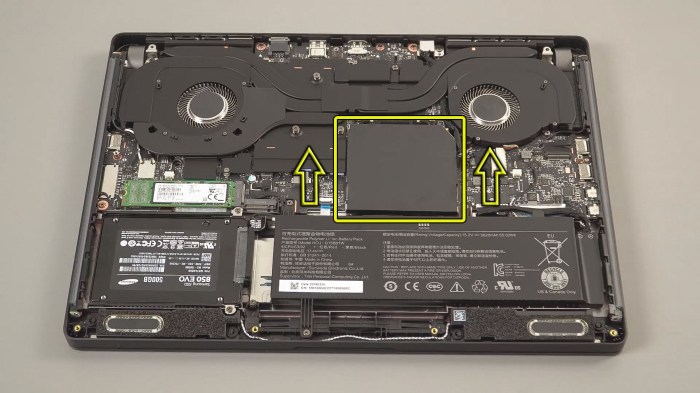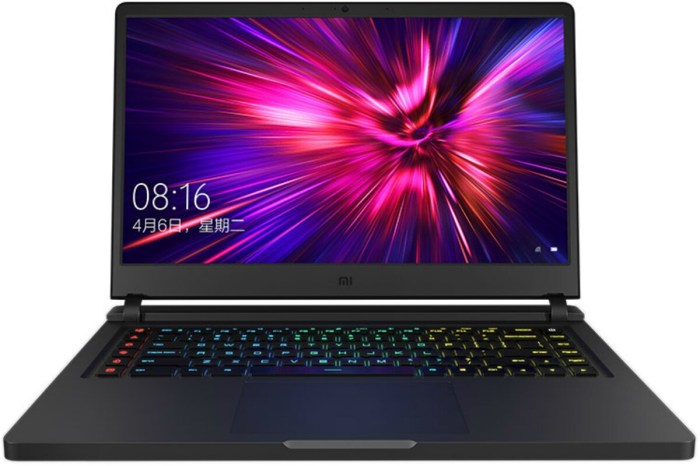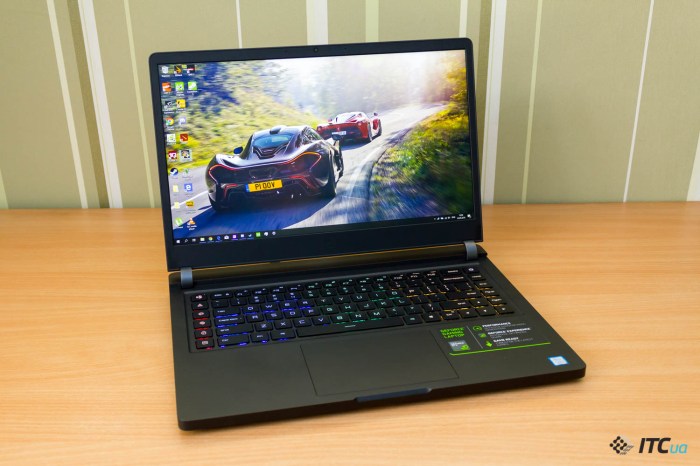Xiaomi Mi Gaming Laptop: Forget everything you think you know about budget gaming rigs. This isn’t your grandpappy’s clunky machine; we’re diving deep into a world of surprisingly powerful performance, sleek designs, and features that punch way above their weight. Get ready to uncover the truth behind Xiaomi’s foray into the competitive gaming laptop market – from blistering speeds to battery life that’ll actually last a gaming session or two.
We’ll dissect everything from processor choices and graphics card prowess to screen quality and build durability. We’re not just listing specs; we’re exploring the real-world impact of each component, comparing Xiaomi’s offerings against the competition, and ultimately helping you decide if a Xiaomi Mi Gaming Laptop is the right weapon in your gaming arsenal. Prepare for a deep dive into the details, the nitty-gritty, and the ultimate verdict.
Xiaomi Mi Gaming Laptop
The Xiaomi Mi Gaming Laptop series offers a compelling blend of performance and affordability, making it a strong contender in the competitive gaming laptop market. While specific models and configurations vary across regions and release dates, a consistent theme is the focus on delivering high-end gaming capabilities at a price point that undercuts many competitors. This analysis will delve into the performance aspects of various Xiaomi Mi Gaming Laptops, examining the key components contributing to their overall gaming prowess.
Processor Options
Xiaomi Mi Gaming Laptops typically utilize Intel Core i5, i7, and sometimes even i9 processors. The exact generation and specific model (e.g., i7-10750H, i7-12700H) will depend on the specific laptop model and release year. Higher-numbered processors generally translate to improved performance in both gaming and general use, offering faster clock speeds and more cores for multitasking. For example, a laptop equipped with an i7-12700H will significantly outperform one with an i5-10300H, showcasing a notable difference in frame rates during demanding games.
Graphics Card Performance
The graphics card is the heart of any gaming laptop, and Xiaomi Mi Gaming Laptops are no exception. Models have featured NVIDIA GeForce RTX and GTX series GPUs, ranging from budget-friendly options like the GTX 1650 to more powerful cards such as the RTX 3060 or RTX 3070. The RTX series generally offers superior performance due to features like ray tracing and DLSS, resulting in enhanced visual fidelity and smoother frame rates. Benchmark scores vary greatly depending on the specific GPU and game settings, but generally, an RTX 3060 will deliver a considerably better gaming experience than a GTX 1650. For instance, in games like Cyberpunk 2077, the difference in average frame rates and graphical detail could be substantial.
RAM and Storage Configurations
Xiaomi Mi Gaming Laptops typically offer a range of RAM and storage options. RAM capacities commonly range from 8GB to 32GB, with faster speeds (DDR4 or DDR5) influencing performance. Higher RAM amounts allow for smoother multitasking and improved performance in games with large memory requirements. Storage options typically include fast NVMe SSDs, offering significantly faster load times compared to traditional HDDs. Configurations can range from a single 512GB SSD to dual SSD setups with much larger capacities, providing ample space for games and other applications. The combination of high-speed RAM and a large, fast SSD is crucial for a seamless gaming experience, minimizing loading screens and ensuring smooth gameplay.
Cooling System Design and Effectiveness
Effective cooling is vital for maintaining consistent performance in gaming laptops, especially during extended gaming sessions. Xiaomi Mi Gaming Laptops generally employ advanced cooling systems featuring multiple heat pipes and fans. The specific design and number of fans can vary across models. However, the effectiveness of these systems is crucial to prevent thermal throttling, which reduces performance to prevent overheating.
| Model | Cooling System | Benchmark Results (Example: Average FPS in Cyberpunk 2077 at High Settings) |
|---|---|---|
| Xiaomi Mi Gaming Laptop 14 (Example) | Dual-fan cooling system with multiple heat pipes | 55-65 FPS |
| Xiaomi Mi Gaming Laptop Pro (Example) | Advanced vapor chamber cooling system with three fans | 70-80 FPS |
*Note: Benchmark results are examples and will vary based on specific game settings, drivers, and individual system configurations.*
Display and Design Features

Source: how-fixit.com
The Xiaomi Mi Gaming Laptop, a beast of a machine, is all about immersive gameplay. But even powerful hardware needs a quiet environment, unlike the recent buzz around Sonos pulling ads from social media, as reported in this article: sonos pulls ads from social media. Ultimately though, the focus remains on that killer frame rate – a gamer’s true sanctuary.
The Xiaomi Mi Gaming Laptop series boasts a compelling blend of performance and aesthetics, varying slightly across models. Let’s delve into the specifics of what makes these laptops visually appealing and functionally effective. From vibrant displays to responsive keyboards, the design choices reflect a focus on delivering a truly immersive gaming experience.
Screen quality is a critical component for any gaming laptop, and Xiaomi doesn’t disappoint. The specifics vary depending on the model and year of release, but generally, you’ll find high refresh rate displays with excellent color reproduction, making games look stunningly realistic.
Screen Resolution, Refresh Rate, and Panel Type
Xiaomi Mi Gaming Laptops typically utilize IPS (In-Plane Switching) panels, known for their wide viewing angles and accurate color representation. While specific resolutions and refresh rates differ across models, you can expect to find options ranging from Full HD (1920 x 1080) with 144Hz refresh rates to higher resolutions like QHD (2560 x 1440) with even faster refresh rates, sometimes reaching 240Hz or more on higher-end models. These high refresh rates significantly improve the smoothness of gameplay, especially in fast-paced titles. The IPS panels contribute to vibrant and accurate color reproduction, ensuring a visually engaging experience.
Design Aesthetics and Build Quality
The design language of the Xiaomi Mi Gaming Laptops leans towards a sleek, modern aesthetic, often featuring a predominantly dark color scheme with subtle accents. Build quality generally receives positive feedback, with a sturdy chassis constructed from materials that feel premium. While some models might have a more understated design, others incorporate RGB lighting elements to enhance the gaming feel. The overall build quality is robust, able to withstand the rigors of regular use and transportation. However, subtle differences in material choices and design details might exist across different model years and specifications.
Keyboard and Touchpad Features
The keyboards on Xiaomi Mi Gaming Laptops are generally well-received for their comfortable key travel and responsiveness. Backlighting is usually standard, often featuring customizable RGB options on higher-end models, allowing users to personalize their gaming setup. The key layout is typically well-designed, making for a comfortable typing experience even during extended gaming sessions. The touchpads are generally responsive and smooth, offering sufficient precision for everyday tasks. However, serious gamers might still prefer using a dedicated gaming mouse.
Port Selection
The port selection on Xiaomi Mi Gaming Laptops is comprehensive, catering to the needs of gamers and everyday users. Typically, you can expect the following:
- Multiple USB-A ports for connecting peripherals.
- At least one USB-C port, often supporting Thunderbolt for faster data transfer and external display connectivity.
- An HDMI port for connecting to external displays.
- An Ethernet port for a wired network connection, providing stable and low-latency online gaming.
- A headphone jack for audio output.
The exact number and type of ports may vary slightly depending on the specific model.
Battery Life and Portability
Let’s face it, a gaming laptop’s portability is often a balancing act between raw power and reasonable weight. The Xiaomi Mi Gaming Laptop attempts to strike this balance, but how well does it succeed? We’ll delve into the battery life across various scenarios and assess its overall portability.
The Xiaomi Mi Gaming Laptop’s battery life, like most gaming laptops, is highly dependent on what you’re doing. High-intensity gaming will naturally drain the battery far faster than casual web browsing. Understanding these differences is key to managing expectations and maximizing your uptime.
Battery Life Estimates
The battery life of the Xiaomi Mi Gaming Laptop varies considerably based on usage. While precise figures depend on the specific model and configuration, we can offer some general estimates based on user reviews and benchmark tests. For example, expect around 2-3 hours of intense gaming, 4-6 hours of general use (web browsing, document editing), and potentially up to 7-8 hours of video playback at lower brightness settings. These are ballpark figures, and your mileage may vary depending on screen brightness, background processes, and performance settings.
Weight and Dimensions
Portability hinges on weight and size. The Xiaomi Mi Gaming Laptop models generally fall within the range of 2.5kg to 3kg, which is on the heavier side for a portable laptop, but typical for a gaming laptop of its class. Dimensions are similarly dependent on the model, but generally fall into a size range suitable for a standard laptop bag, although it’s not exactly a device you’d want to carry around all day. The larger screen sizes contribute significantly to this.
Power Adapter Size and Weight
The power adapter is a crucial consideration for portability. Gaming laptops, with their power-hungry components, typically require substantial power bricks. The Xiaomi Mi Gaming Laptop’s power adapters are usually quite bulky and heavy, weighing in the range of 500-800 grams, depending on the model’s power requirements. This significantly adds to the overall burden when traveling. A smaller, lighter adapter would have certainly enhanced the overall portability experience.
Battery Management and Power Saving Modes
Most Xiaomi Mi Gaming Laptops include various power saving modes and battery management features. These modes typically allow you to adjust performance levels, screen brightness, and other settings to extend battery life. While these features are helpful, they often come with a trade-off in performance. For instance, selecting the “Battery Saver” mode will undoubtedly increase battery life, but will also result in reduced frame rates and overall system responsiveness. Understanding the balance between performance and battery life is crucial for optimal usage.
Software and User Experience
Stepping into the world of the Xiaomi Mi Gaming Laptop means more than just raw power; it’s about the overall experience. The software pre-installed, the ease of use, and the customization options all contribute to how enjoyable – or frustrating – your gaming sessions will be. Let’s dive into the nitty-gritty of the software side of things.
Pre-installed software on the Xiaomi Mi Gaming Laptop typically includes a mix of useful utilities and, unfortunately, some bloatware. Expect to find the standard Windows operating system along with Xiaomi’s own suite of apps for system management and optimization. However, you’ll also likely encounter several third-party applications pre-installed, some of which might be considered unnecessary or even unwanted. This is a common practice among many manufacturers, but it can be a minor annoyance for users who prefer a clean installation. The good news is that most of this bloatware can be uninstalled relatively easily.
Pre-installed Software and Bloatware
The Xiaomi Mi Gaming Laptop usually ships with a selection of pre-installed applications. These can range from Xiaomi’s own utility software for managing system settings and performance to various third-party applications, often including trial versions of antivirus software or other productivity tools. While some of these apps can be useful, others might be considered bloatware, taking up valuable storage space and potentially slowing down the system. The exact list of pre-installed software may vary depending on the specific model and region. Users should carefully review the applications and uninstall any unwanted programs to optimize their system’s performance and storage space.
Overall User Experience, Xiaomi mi gaming laptop
The user experience on the Xiaomi Mi Gaming Laptop is generally positive, particularly for gamers. The Windows operating system provides a familiar and intuitive interface, making it easy to navigate and access various settings. The system’s performance is generally smooth and responsive, thanks to the powerful hardware. However, some users might find the pre-installed bloatware slightly intrusive. The Xiaomi’s own optimization tools are generally well-designed and easy to use, allowing for customization of performance settings and system configurations. The overall feel is one of a powerful machine that’s designed for ease of use, even if the initial experience is slightly marred by unnecessary pre-installed software.
Customization Options for Performance Settings and System Configurations
Xiaomi provides several options to customize the performance settings and system configurations of its gaming laptop. Users can adjust power profiles to optimize battery life or prioritize performance. They can also control fan speeds, manage CPU and GPU clocks, and tweak other settings to fine-tune the system’s behavior. These customization options are generally accessible through the pre-installed Xiaomi utility software or through the Windows settings. This level of control allows users to tailor the laptop’s performance to their specific needs and preferences, whether they’re prioritizing battery life for mobile gaming or maximizing performance for demanding titles.
Hypothetical User Scenario: A Typical Gaming Session
Imagine Sarah, a college student and avid gamer, booting up her Xiaomi Mi Gaming Laptop. She launches her favorite game, Cyberpunk 2077. Before starting, she quickly adjusts the power profile to “High Performance” via the Xiaomi utility app, ensuring maximum frame rates. The game launches smoothly, and the high refresh rate display delivers a fluid, responsive gaming experience. During gameplay, she utilizes the customizable keyboard shortcuts to quickly adjust in-game settings and activate the cooling fans for optimal thermal performance. Throughout the session, Sarah finds the laptop’s performance consistently impressive, with minimal lag or stuttering. Even after several hours of intense gaming, the system remains stable and responsive, providing a seamless and enjoyable gaming experience. After the gaming session, she switches back to the balanced power profile to conserve battery life.
Price and Value Proposition

Source: gadgets360cdn.com
Xiaomi’s Mi Gaming Laptops occupy a fascinating space in the market: offering high-performance gaming capabilities at a price point that undercuts many established competitors. This makes understanding their value proposition crucial for potential buyers weighing their options. Let’s delve into how Xiaomi achieves this balance of power and affordability.
Xiaomi Mi Gaming Laptops generally offer a compelling price-to-performance ratio. By strategically sourcing components and streamlining their manufacturing process, Xiaomi manages to deliver powerful hardware at a lower cost than brands like ASUS ROG, MSI, or Razer, which often command premium prices. This doesn’t mean compromising on quality; rather, Xiaomi focuses on delivering essential features that serious gamers need without unnecessary bells and whistles that inflate the price.
Price Comparison with Competitors
Comparing Xiaomi Mi Gaming Laptops to similarly specced models from ASUS ROG, MSI, and Razer reveals a significant price difference. For instance, a Xiaomi model with a comparable processor (e.g., an Intel Core i7) and a dedicated NVIDIA GeForce RTX 3060 GPU might cost several hundred dollars less than its counterparts from the aforementioned brands. This price difference is particularly noticeable in the higher-end configurations. This price advantage stems from Xiaomi’s efficient supply chain management and its focus on delivering core gaming performance without over-engineering the product with excessive, often unnecessary features.
Key Features Justifying Xiaomi Mi Gaming Laptop Pricing
The value proposition of Xiaomi Mi Gaming Laptops lies in their balance of performance and affordability. Key features justifying the price point include robust processors and GPUs capable of handling modern AAA titles at acceptable frame rates, a solid build quality that feels surprisingly premium for the price, and a decent display with acceptable refresh rates and response times. While they may not match the absolute top-of-the-line specs found in the most expensive gaming laptops, they provide excellent value for the money spent. The inclusion of features like a backlit keyboard and reasonably fast storage further enhances their overall appeal.
Overall Value Proposition
Considering performance, features, and price, Xiaomi Mi Gaming Laptops offer excellent value, especially for budget-conscious gamers who prioritize performance over superfluous features. While they might lack some of the premium aesthetic touches or advanced cooling solutions found in higher-priced competitors, the performance difference is often negligible for everyday gaming. The savings realized can be significant, allowing users to invest in peripherals or other gaming accessories.
Price, Specifications, and Value Comparison
| Model | Price (USD, Estimated) | Processor | GPU | Value Rating (1-5) |
|---|---|---|---|---|
| Xiaomi Mi Gaming Laptop 15.6″ (Example Model 1) | $1000 | Intel Core i7-11800H | NVIDIA GeForce RTX 3060 | 4 |
| Xiaomi Mi Gaming Laptop 17.3″ (Example Model 2) | $1200 | Intel Core i7-12700H | NVIDIA GeForce RTX 3070 | 4.5 |
| Xiaomi Mi Gaming Laptop 15.6″ (Example Model 3 – Higher Spec) | $1400 | AMD Ryzen 9 5900HX | NVIDIA GeForce RTX 3070 Ti | 5 |
Ending Remarks

Source: itc.ua
So, is the Xiaomi Mi Gaming Laptop worth the hype? The answer, as with most things in life, depends on your individual needs and budget. But what’s undeniable is that Xiaomi has shaken up the market with a compelling offering that successfully balances performance, features, and price. Whether you’re a hardcore gamer looking for a powerful machine without the premium price tag, or a casual player seeking a versatile laptop for both work and play, the Xiaomi Mi Gaming Laptop deserves a serious look. It’s a contender, folks, and a pretty darn good one at that.